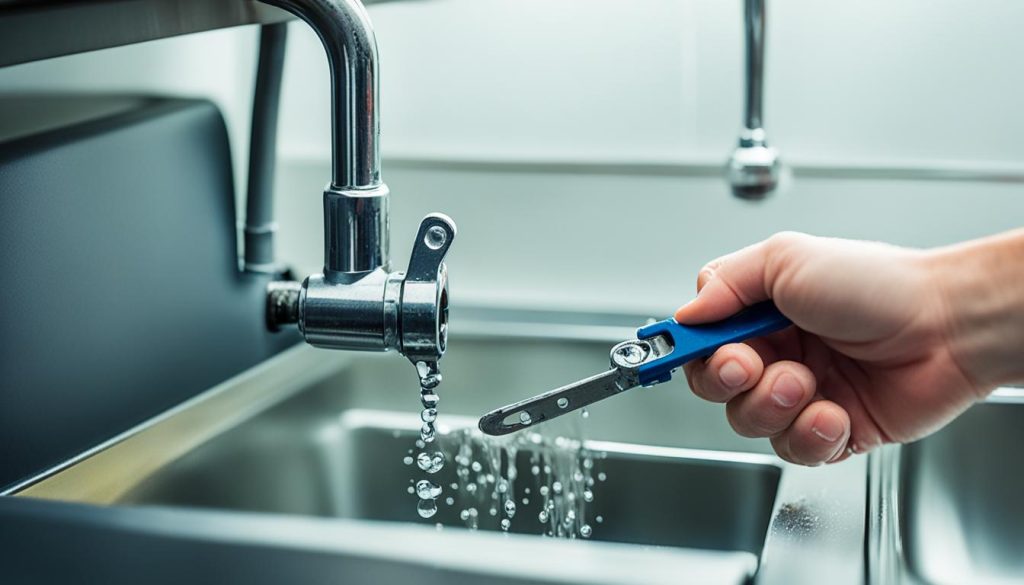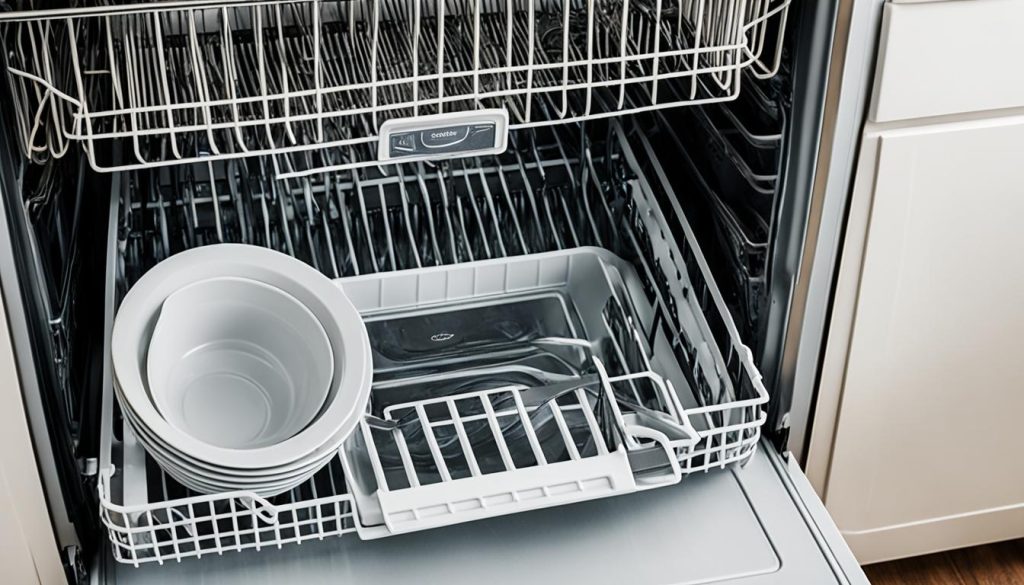Troubleshooting a Whirlpool Dishwasher Not Draining
Did you know that a staggering 30% of dishwasher issues reported by homeowners involve drainage problems? If you’re experiencing a Whirlpool dishwasher not draining properly, you’re not alone. It can be a frustrating situation, but the good news is that there are steps you can take to troubleshoot and resolve the issue before calling in a professional. In this article, I will guide you through the common causes of a dishwasher not draining, as well as the steps you can take to fix it yourself.
Key Takeaways:
- 30% of reported dishwasher issues are related to drainage problems.
- You can troubleshoot and fix a Whirlpool dishwasher not draining before calling a professional.
- Common causes of a dishwasher not draining include a clogged filter, a malfunctioning drain valve, or a broken drain pump.
- The troubleshooting steps in this article will help you identify and resolve the problem.
- If all else fails, consider contacting a professional appliance repair service.
Step 1: Start with the Filter
One of the most common reasons for a dishwasher not draining properly is a clogged filter. The filter, located at the bottom of the tub, can accumulate food particles and debris over time, obstructing the drainage process. To fix this issue, follow these steps:
- Remove the bottom dish rack to access the filter assembly.
- Take out the filter and rinse it under the sink faucet to remove any soil or debris.
- Use a soft brush to scrub away stubborn particles.
- Once the filter is clean, securely replace it.
This simple step can often resolve the problem of a dishwasher not draining. Check the filter regularly and clean it to ensure optimal drainage performance.
| Pros: | Cons: |
|---|---|
| Easy and quick fix | May not solve all drainage issues |
| Prevents clogs | Requires regular maintenance |
| Improves dishwasher performance |
Step 2: Remove the Garbage Disposal Knockout Plug
If your Whirlpool dishwasher is not draining and you have recently installed a new garbage disposal, it’s important to check if the knockout plug has been removed. The knockout plug is a small piece that blocks the drain connection between the garbage disposal and the dishwasher. If it is still in place, the dishwasher won’t drain properly.
To remove the knockout plug, follow these steps:
- Disconnect the dishwasher drain hose from the garbage disposal.
- Use a pencil or other small object to feel for the plug inside the inlet of the garbage disposal.
- If you can feel the plug, remove it to allow for proper drainage.
Steps to Remove the Garbage Disposal Knockout Plug
| Step | Description |
|---|---|
| Step 1 | Disconnect the dishwasher drain hose from the garbage disposal. |
| Step 2 | Use a pencil or other small object to feel for the plug inside the inlet of the garbage disposal. |
| Step 3 | If you can feel the plug, remove it to allow for proper drainage. |
Check for Kinks in the Drain Hose
If your Whirlpool dishwasher is not draining water, one possible cause could be a kink in the drain hose. When installing the dishwasher, it’s easy for the hose to become bent or twisted, blocking the flow of water.
To check for kinks in the drain hose, follow these steps:
- Disconnect the dishwasher from power to ensure safety.
- Carefully inspect the drain hose for any bends or twists.
- If you find a kink, straighten it out gently to allow for proper drainage.
Once you have straightened any kinks in the drain hose, reconnect your dishwasher to power and run a cycle to see if the problem has been resolved.
Test the Drain Pump
If you have tried cleaning the filter and checking for kinks in the drain hose but your Whirlpool dishwasher still won’t drain, the next step is to test the drain pump. The drain pump is responsible for pumping water out of the dishwasher.
To test the drain pump, you can use a multimeter to check for continuity. If there is no continuity, or if the pump is not working despite having power, it may need to be replaced. A malfunctioning drain pump can cause the dishwasher to not drain properly.
Testing the drain pump is a simple process that can help pinpoint the problem and guide you towards an effective solution. By following the steps below, you can determine if the drain pump is the culprit.
Steps to test the drain pump:
- Disconnect the dishwasher from power to ensure your safety during the testing process.
- Locate the drain pump in your Whirlpool dishwasher. It is usually located at the bottom, near the drain hose.
- Remove any screws or clips that secure the drain pump in place.
- Disconnect the wires attached to the pump terminals.
- Set your multimeter to the continuity test mode.
- Tightly touch the multimeter probes to the terminals of the drain pump.
- If the multimeter shows continuity (a complete circuit), it means that the drain pump is functioning correctly.
- If there is no continuity, or if the multimeter does not display any reading, it indicates a problem with the drain pump. In this case, you may need to replace the pump to resolve the issue.
By conducting this simple test, you can determine if the drain pump is the reason behind your Whirlpool dishwasher not draining effectively. If you find that the drain pump is faulty, it is recommended to consult with a professional technician or contact the Whirlpool customer support for further assistance in obtaining a replacement pump and guidance on proper installation.
| Common Signs of a Faulty Drain Pump: | Possible Solutions: |
|---|---|
| 1. Dishwasher not draining at all or draining slowly. | 1. Test the drain pump for continuity. If there is no continuity, replace the pump. |
| 2. Unusual noises coming from the drain pump. | 2. Inspect the drain pump for any visible damage or debris. Clean or replace if necessary. |
| 3. Water accumulating at the bottom of the dishwasher. | 3. Check the drain pump for clogs or blockages. Remove any debris that may be obstructing the pump’s operation. |
| 4. Error codes indicating a drain pump issue. | 4. Reset your dishwasher and perform a diagnostic test cycle. If the error code persists, replace the drain pump. |
Check the Drain Impeller and Valve
If your Whirlpool dishwasher is not draining at the end of the cycle and the drain pump is not the issue, you should check the drain impeller and valve. The drain impeller propels water through the drain hose, while the drain valve controls the flow of water out of the dishwasher. If the impeller is broken or the valve is clogged with debris, water will not be able to properly drain. In these cases, the impeller or valve may need to be replaced to restore proper drainage.
Other Possible Causes and Next Steps
If none of the previous troubleshooting steps have resolved the issue of your Whirlpool dishwasher not draining, there are a few other possible causes to consider. A clogged garbage disposal, a blocked air gap, or a defective drain valve may be the culprits.
To fix these problems, start by cleaning out the garbage disposal. Food particles and debris can accumulate over time, obstructing the flow of water. Clearing any blockages in the air gap is also important. The air gap is a small device located next to the sink faucet that prevents wastewater from flowing back into the dishwasher.
If cleaning the garbage disposal and clearing the air gap don’t solve the issue, the next step is to check the drain valve. A defective or clogged drain valve can prevent the dishwasher from draining properly. If necessary, you can replace the drain valve to restore proper drainage.
If you have tried all of these steps and are still unable to diagnose or fix the issue yourself, it may be time to call a professional appliance repair service. They have the expertise and tools necessary to identify and resolve complex dishwasher problems. By seeking professional assistance, you can ensure that your Whirlpool dishwasher is back to functioning properly and that you can enjoy clean and sparkling dishes once again.
- Investing Wisely: How Windows & Doors in Boost Property Value and Financial Health - April 24, 2025
- The Financial Impact of Personal Injuries: Why Legal Help Matters for Business Owners - April 16, 2025
- The Hidden Financial Costs of Domestic Assault: What Business Owners Need to Know - April 16, 2025














